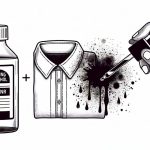To get dried paint out of clothes, first identify the type of paint—water-based or oil-based. Gently scrape off excess paint and blot with warm, soapy water for water-based paint, or use rubbing alcohol for oil-based. Pre-treat the stain with detergent, letting it sit for 5-10 minutes. Wash in the hottest water safe for the fabric, avoiding fabric softener. Air-dry to prevent setting any remaining stains. For more effective techniques and tips, explore additional methods ahead.
Table of Contents
Key Takeaways
- Identify the paint type: water-based or oil-based, as this determines the removal method needed.
- Gently scrape excess dried paint with a plastic knife or credit card before attempting deeper cleaning.
- For water-based paint, soak the stain with warm, soapy water; for oil-based, use rubbing alcohol or paint thinner.
- Pre-treat the stain with detergent, let it sit for 5-10 minutes, then rinse with warm water.
- Wash the garment in the hottest water allowed by the care label, avoiding fabric softener, and air-dry to prevent setting stains.
Understanding the Type of Paint
When tackling dried paint stains, it’s essential to understand the type of paint involved. Water-based paints, like acrylic or latex, can be easier to remove compared to oil-based paints, which often require more effort and specific solvents.
If you’re unsure, check the label on your paint container or examine the stain closely. Water-based paints typically feel slightly rubbery when dry, while oil-based paints have a harder, glossy finish. Knowing the paint type can help you choose the right removal method and avoid damaging your fabric.
Initial Removal Techniques
Now that you’ve identified the type of paint, it’s time to tackle the stain with some effective initial removal techniques. Start by gently scraping off any excess paint with a plastic knife or credit card, taking care not to damage the fabric. Next, blot the stain with a clean cloth soaked in warm water. For oil-based paints, use a solvent like rubbing alcohol. If it’s water-based paint, a mixture of dish soap and water works well.
Here’s a quick reference table to guide you:
| Paint Type | Initial Action | Recommended Solvent |
|---|---|---|
| Oil-based | Scrape, then blot | Rubbing alcohol |
| Water-based | Scrape, then blot | Dish soap and water |
| Acrylic | Scrape, then blot | Warm soapy water |
| Latex | Scrape, then blot | Warm soapy water |
Effective Pre-Treatment Methods
Before tackling dried paint, you’ll want to prepare your fabric with some effective pre-treatment methods.
Start by rinsing the area with warm water, then apply a suitable detergent to break down the paint.
If the stain persists, soaking the fabric can give you an extra edge in removing it.
Warm Water Rinse
To effectively tackle dried paint on your clothes, starting with a warm water rinse can make a significant difference.
First, take your stained garment to the sink or bathtub. Run warm water over the area with the dried paint, allowing it to soak for a few minutes. This helps to soften the paint, making it easier to remove.
Make sure the water isn’t too hot, as extreme heat can set the stain further. Gently rub the fabric with your fingers or a soft cloth to help lift the paint. Keep rinsing until you see some of the paint loosening.
This initial step prepares your fabric for more intensive treatments, setting you up for success in getting rid of that stubborn stain.
Detergent Application
Once you’ve rinsed the stained area with warm water, applying a suitable detergent can greatly enhance your chances of removing the dried paint.
Choose a detergent that’s designed to break down tough stains. Here’s how to effectively apply it:
- Apply Directly: Squeeze a small amount of detergent directly onto the stained area. Make sure to cover the paint thoroughly.
- Gently Rub: Using your fingers or a soft brush, gently rub the fabric together. This helps the detergent penetrate the paint.
- Let It Sit: Allow the detergent to sit on the stain for about 5-10 minutes. This gives it time to work on breaking down the paint.
After this, you can proceed to rinse again and check the results!
Soaking Techniques
Soaking techniques can be a game-changer when it comes to treating dried paint stains.
Start by filling a basin or sink with warm water, and add a few drops of dish soap or laundry detergent. Submerge the stained area of your clothing, letting it soak for at least 30 minutes. This helps to loosen the paint.
If the paint is stubborn, you can also mix in some white vinegar for added effectiveness. After soaking, gently scrub the area with a soft brush or cloth to lift the paint.
Rinse thoroughly with cold water before washing as usual. Remember, patience is key; sometimes, you might need to repeat the soaking process for tough stains.
Choosing the Right Solvents
Choosing the right solvent is essential for effectively removing dried paint from your clothes, as different types of paint require specific treatments.
Selecting the appropriate solvent is crucial for effectively eliminating dried paint from fabric, as various paint types demand unique approaches.
Here’s a quick guide to help you choose:
- Water-Based Paint: Use warm water or a mixture of soap and water. This is often the easiest to remove, as it dissolves with moisture.
- Oil-Based Paint: Opt for paint thinner or mineral spirits. These solvents penetrate and break down the oil-based paint effectively.
- Acrylic Paint: Rubbing alcohol works well for acrylics. Apply it directly to the stain, letting it sit for a few minutes before blotting.
Always test the solvent on a small, inconspicuous area first to guarantee it won’t damage the fabric.
Agitation and Rinsing Process
While treating the dried paint, you’ll need to incorporate agitation to help lift the stain effectively. Start by applying your chosen solvent directly onto the paint.
Use a soft cloth or sponge to gently rub the area in a circular motion. This friction helps break down the paint’s bond with the fabric. Keep an eye on the stain; if it starts to lift, continue your agitation for a few more seconds.
Once you’ve agitated the area sufficiently, rinse the fabric under cold running water. Make sure the water flows through the stained side to push the paint out.
If any residue remains, repeat the agitation and rinsing. This process is essential for removing as much paint as possible before moving on to washing your garment.
Proper Washing and Drying Practices
When it comes to getting dried paint out of your clothes, using the right washing techniques is essential.
Make sure to select a machine setting that suits the fabric type while keeping an eye on the water temperature.
After washing, consider your drying method carefully, as heat can set any remaining paint stains.
Machine Washing Techniques
To effectively remove dried paint from clothes, you’ll want to follow a few key machine washing techniques that guarantee the best results.
First, make sure to pre-treat the stained area with a stain remover or a bit of detergent, allowing it to sit for at least 15 minutes.
Next, wash your clothes in the hottest water recommended on the care label, as heat can help break down the paint.
Finally, avoid adding fabric softener, which may lock in the stain instead of removing it.
- Pre-treat with a stain remover.
- Wash in the hottest water allowed.
- Skip fabric softener during the wash.
Drying Method Considerations
After washing your clothes, how you dry them can greatly impact the success of removing dried paint stains. Instead of tossing them straight into the dryer, consider air-drying first.
High heat can set the paint stain, making it harder to remove. Hang your clothes in a well-ventilated area, allowing any remaining moisture to evaporate.
Keep an eye on the stains; if they’re still visible after washing, treat them again before drying. You can also use a fan to speed up the drying process without applying heat.
Once you’re confident the stain is gone, you can safely tumble dry your clothes. Remember, patience is key when dealing with stubborn paint stains!
Preventive Measures for Future Stains
Although accidents happen, you can take simple steps to protect your clothes from future paint stains.
By being proactive, you’ll save yourself the hassle of cleaning later. Here are three effective preventive measures:
- Wear Protective Clothing: Always don an old shirt or apron when painting. This creates a barrier between your clothes and any potential splashes.
- Choose the Right Workspace: Set up your painting area on a drop cloth or newspaper. This minimizes the risk of paint drips reaching your clothes.
- Keep Paint Containers Secure: Confirm lids are tightly closed when not in use. This reduces the chance of spills while you’re working.
Frequently Asked Questions
Can I Use Vinegar to Remove Dried Paint Stains?
Yes, you can use vinegar to help remove dried paint stains. Its acidity may break down the paint. Just apply it, let it sit for a while, then scrub gently and rinse thoroughly.
What if the Paint Stain Is on Delicate Fabric?
Treating paint stains on delicate fabric feels like walking on eggshells. You should act quickly, using a gentle solvent or rubbing alcohol. Always test a small area first to avoid damaging the fabric’s delicate fibers.
How Can I Prevent Paint Stains in the Future?
To prevent paint stains, you should always wear old clothes when painting and use drop cloths to protect surfaces. Also, keep paint away from your skin and use brushes with controlled application to minimize splatters.
Is It Safe to Use Bleach on Paint Stains?
Using bleach on paint stains isn’t safe. It can react unpredictably, potentially damaging your fabric. Instead, focus on gentler methods specific to the type of paint, ensuring your clothes stay intact while tackling those stains.
How Long Should I Let Solvents Sit on the Stain?
You might think letting solvents sit longer means better results, but it doesn’t. Generally, you should let them sit for about five to ten minutes. Check the stain before deciding whether to reapply.
- Bloodstain on a Delicate Lace Garment - June 9, 2025
- How to Get Gum Out of Wool Clothing - June 9, 2025
- Turmeric on a Silk Saree, Stain Removal - June 9, 2025






